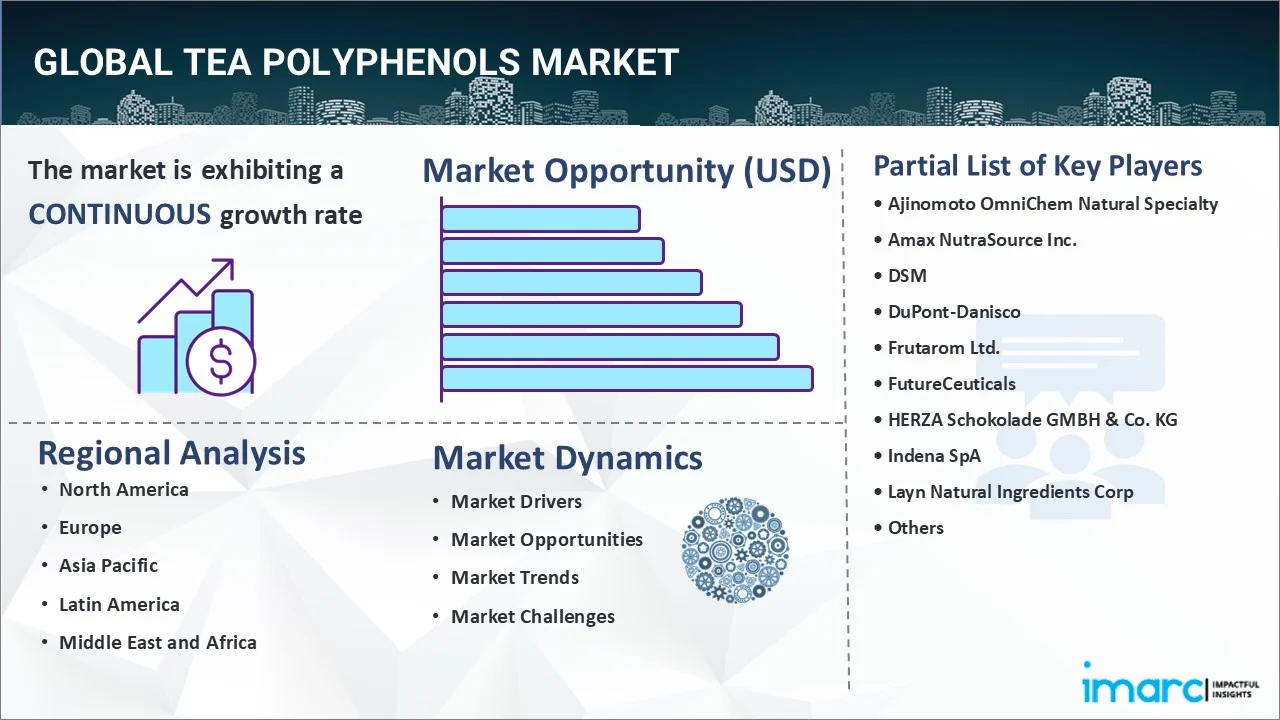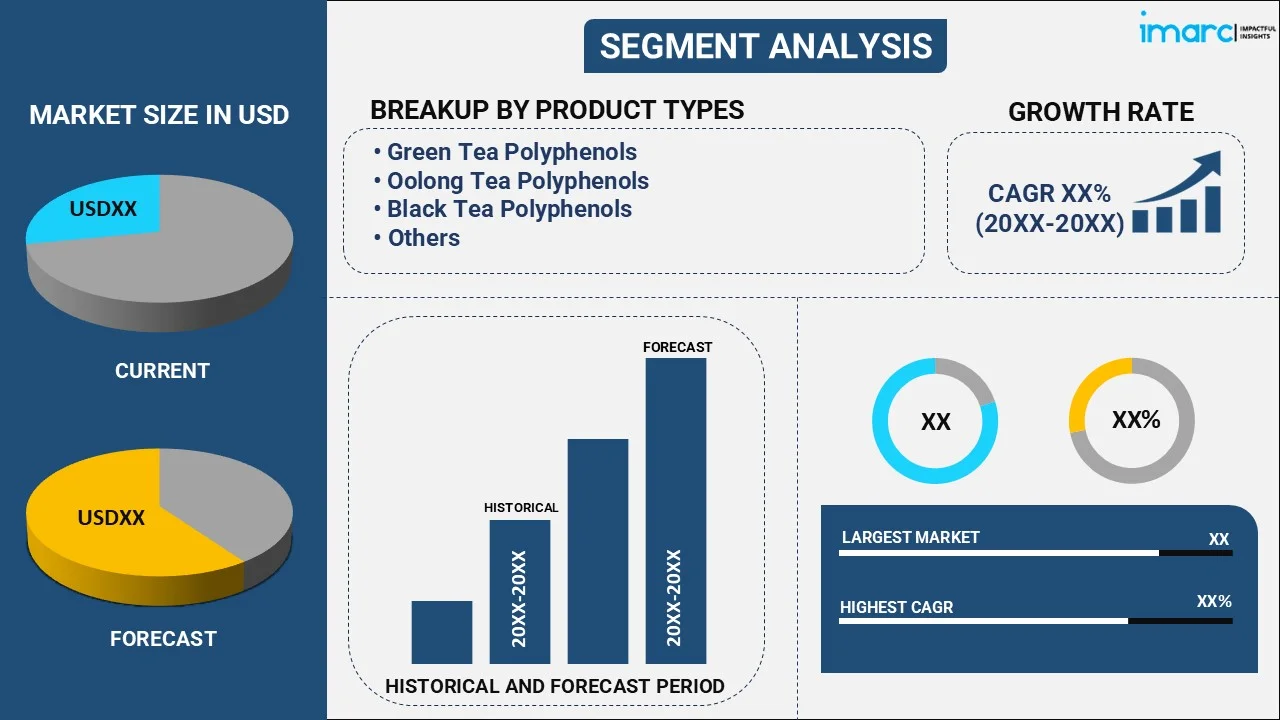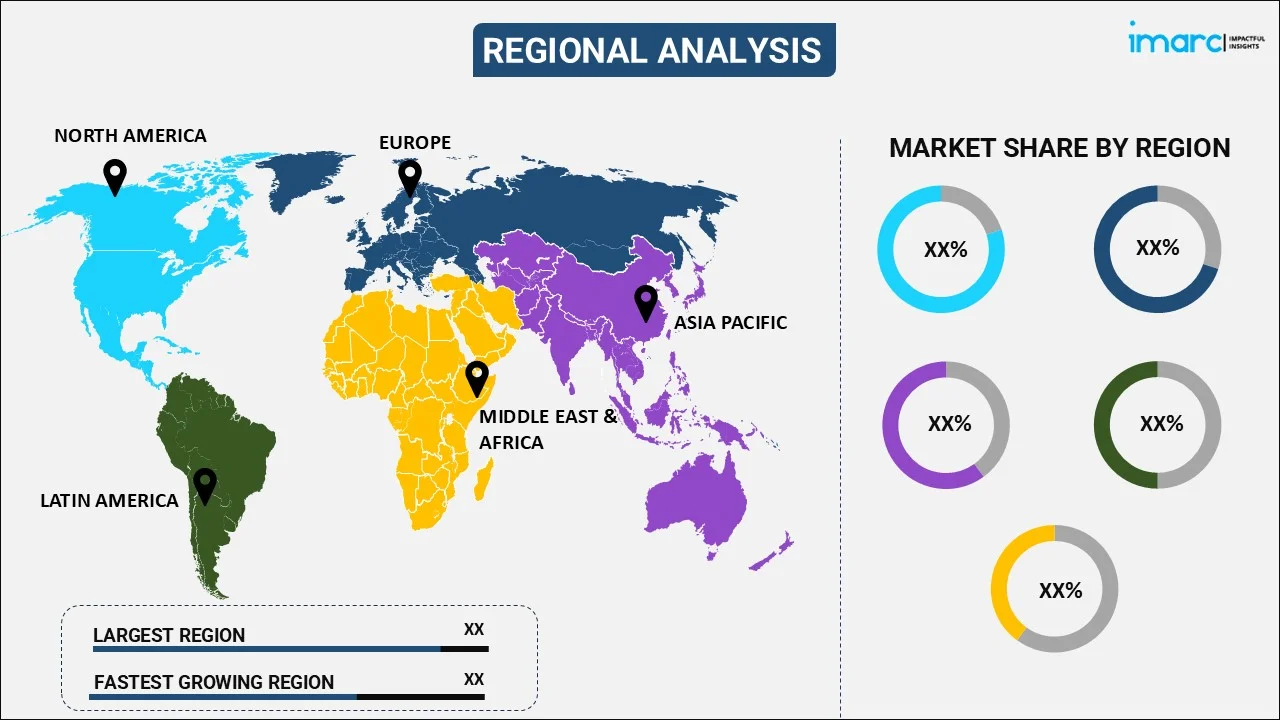
Tea Polyphenols Market Report by Product Type (Green Tea Polyphenols, Oolong Tea Polyphenols, Black Tea Polyphenols, and Others), Application (Functional Beverages, Functional Food, Dietary Supplements, and Others), Distribution Channel (Mass Retailers, Direct Selling, Online Retailers, and Others), and Region 2025-2033
Market Overview:
The global tea polyphenols market size reached USD 474.0 Million in 2024. Looking forward, IMARC Group expects the market to reach USD 838.0 Million by 2033, exhibiting a growth rate (CAGR) of 6.5% during 2025-2033. The market is experiencing significant growth due to shifting consumer preference for natural and healthy food and beverage products, along with the expanding product utilization in the nutraceutical and cosmetic sectors. At present, Asia Pacific holds the largest market share, driven by rising health-consciousness among the masses and increasing government initiatives promoting traditional herbal and natural products.
|
Report Attribute
|
Key Statistics
|
|---|---|
|
Base Year
|
2024
|
|
Forecast Years
|
2025-2033
|
|
Historical Years
|
2019-2024
|
|
Market Size in 2024
|
USD 474.0 Million |
|
Market Forecast in 2033
|
USD 838.0 Million |
| Market Growth Rate (2025-2033) | 6.5% |
Tea Polyphenols Market Analysis:
- Major Market Drivers: The rising demand for natural health products, such as tea polyphenols, is driven by their antioxidant, anti-inflammatory, and anti-cancer properties. Consumers' preference for healthier alternatives, increased awareness of chronic diseases, and heightened concerns regarding synthetic ingredients are contributing to the growth of the market.
- Key Market Trends: The growing interest in functional beverages enriched with tea polyphenols is a significant trend. These beverages provide health benefits, such as improved metabolism and cardiovascular health, which appeal to health-conscious consumers. Tea polyphenols are increasingly used in cosmetics and dietary supplements as well.
- Geographical Trends: The Asia Pacific region dominates the market due to its long history of tea consumption. Growing health awareness and rising disposable incomes across the region are also fueling the product demand in Asia Pacific.
- Competitive Landscape: Some of the key players include Ajinomoto OmniChem Natural Specialty, Amax NutraSource Inc., DSM, DuPont-Danisco, Frutarom Ltd., FutureCeuticals, HERZA Schokolade GMBH & Co. KG, Indena SpA, Layn Natural Ingredients Corp, Naturex, Seppic and Tianjin Jianfeng Natural Products. These companies play a vital role in shaping the market, benefiting from strong consumer demand and innovations in tea polyphenol extraction and product development across health-related sectors.
- Challenges and Opportunities: The market faces disruptions in supply chains, raw material shortages, and increased prices. Strong competition among established players and high switching costs also hinders new entrants, making market penetration difficult for smaller companies. However, the growing demand for functional beverages, supplements, and natural cosmetics presents significant opportunities. Moreover, increased health consciousness and advancements in extraction technologies provide avenues for product innovation and market expansion.
The growing demand for natural health products.
Tea polyphenols are compounds that are naturally found in tea and are known to have strong antioxidant properties. These compounds help to reduce the risk of certain diseases and promote overall health and well-being. The health benefits of tea polyphenols have been widely publicized and studied, leading to an increased demand for these compounds. In addition to this, with the rising prevalence of numerous chronic diseases caused by changing lifestyles and dietary habits, consumers are looking to incorporate natural and healthy products and supplements in their diets, which is creating a positive outlook for the tea polyphenols market. Moreover, the escalating health consciousness and consumer concerns about the side effects of synthetic ingredients are aiding in market expansion. Apart from this, the surging demand for functional beverages with rich nutritional profiles, such as green, black, or oolong tea, is acting as another growth-inducing factor.

Competitive analysis such as market structure, market share by key players, player positioning, top winning strategies, competitive dashboard, and company evaluation quadrant has been covered in the report. Also, detailed profiles of all major companies have been provided. The market structure is consolidated in nature due to the presence of numerous regional and international market players and the emergence of small and medium-sized companies. However, the volume of new entrants in the tea polyphenols industry is low due to the strong position of leading market players with the majority of market shares, low product differentiation, and switching costs.
What are Tea Polyphenols?
Tea polyphenols are natural compounds found in tea leaves, particularly in green tea. They are a type of flavonoid, which is a class of plant-derived compounds known for their antioxidant properties. The main types of tea polyphenols found in tea leaves are epicatechin (EC), epicatechin gallate (ECG), epigallocatechin (EGC), and epigallocatechin gallate (EGCG). Tea polyphenols exhibit antioxidant, anti-inflammatory, anti-cancer, and anti-diabetic properties. They work by neutralizing free radicals in the body, which can damage cells and contribute to chronic diseases. Moreover, they also offer numerous health benefits such as improved blood vessel function, blood pressure regulation, and reduced risks of cardiovascular disorders (CVDs), cancer, and stroke. On account of these properties, they are broadly used as a fundamental ingredient in dietary supplements, organic colors, cosmetics, and food and beverage (F&B) products.
COVID-19 Impact:
The Covid-19 outbreak has had a significant negative impact on the tea polyphenols market due to the disruption of global supply chains. The pandemic has caused a scarcity of raw materials used in the production of tea polyphenols, resulting in a reduced supply and higher prices. Moreover, the limited road movement and restrictions on international trade have impacted deliveries of raw materials as well as final products to the end-consumers, which hampered the market growth. Concurrent with this, the outbreak has caused a decrease in demand as people are forced to stay at home. This has resulted in a decline in sales, leading to a subsequent drop in profits for tea polyphenol manufacturers. In addition to this, during the lockdown, many companies were forced to reduce their marketing budgets or cancel campaigns altogether due to the uncertain economic environment, which resulted in a decrease in brand awareness and overall product sales. This has a detrimental impact on industry expansion.
Tea Polyphenols Market Trends:
The increasing prevalence of chronic diseases, such as obesity, cardiovascular diseases (CVDs), and diabetes, due to sedentary lifestyles and unhealthy eating habits of consumers around the globe. However, with the escalating awareness of health and wellness, people are shifting towards more nutritious diets and adopting an active lifestyle, which is driving the demand for healthier alternatives to traditional beverages, such as tea, and aiding in the growth of the tea polyphenols market. In addition to this, the widespread product adoption as they are a rich source of epigallocatechin gallate (EGCG) and dietary fibers that exhibit anti-inflammatory, antimicrobial, and antineoplastic properties, which aid in improving metabolism and weight management, which is creating a positive outlook for market growth. Moreover, the increasing product utilization in the manufacturing of ready-to-drink (RTD) teas, dietary supplements, nutraceuticals, and functional beverages, is presenting remunerative growth opportunities for the market. Concurrent with this, the increasing use of tea polyphenols in producing various personal care and cosmetic products to combat signs of aging, skin darkness, acne, dandruff, and hair loss, is acting as a significant growth-inducing factor. Furthermore, rapid urbanization, the rising geriatric population, inflating disposable income of individuals, the surging adoption of preventative healthcare, and ongoing technological advancements in extraction technologies are positively impacting the market growth.
Key Market Segmentation:
IMARC Group provides an analysis of the key trends in each sub-segment of the global tea polyphenols market report, along with forecasts at the global, regional and country level from 2025-2033. Our report has categorized the market based on product type, application, and distribution channel.
Product Type Insights:

- Green Tea Polyphenols
- Oolong Tea Polyphenols
- Black Tea Polyphenols
- Others
Green tea polyphenols account for the majority of the market share
The report has provided a detailed breakup and analysis of the market based on the product type. This includes green tea polyphenols, oolong tea polyphenols, black tea polyphenols and others. According to the report, green tea polyphenols represented the largest segment.
Green tea polyphenols dominate the global market due to their high concentration of catechins, particularly epigallocatechin gallate (EGCG), which is well-known for its antioxidant properties. The health benefits associated with green tea polyphenols, such as improved cardiovascular health, weight management, and anti-aging properties, make them popular across various industries, including supplements, cosmetics, and functional beverages. As green tea consumption rises globally, consumers seek products enriched with its polyphenols, further driving the market growth. Moreover, ongoing research into green tea’s potential in reducing cancer risks and improving metabolic health is contributing to tea polyphenols market growth.
Application Insights:
- Functional Beverages
- Functional Food
- Dietary Supplements
- Others
Functional beverages account for the majority of the market share
The report has provided a detailed breakup and analysis of the market based on the application. This includes functional beverages, functional food, dietary supplements, and others. According to the report, functional beverages represented the largest segment.
Functional beverages hold the largest share in the market, driven by consumers' increasing demand for health-enhancing drinks. Tea polyphenols are prized for their natural antioxidant, anti-inflammatory, and metabolism-boosting properties, making them ideal for inclusion in beverages aimed at improving wellness and fitness. Energy drinks, ready-to-drink teas, and enhanced water products often incorporate tea polyphenols to offer consumers enhanced health benefits. The rising trend toward plant-based and organic ingredients in beverages has further propelled the use of the product, as they align with the growing preference for natural solutions. The popularity of functional beverages has been particularly strong in regions where consumers are increasingly opting for beverages that provide added nutritional or health value, beyond simple hydration.
Distribution Channel Insights:
- Mass Retailers
- Direct Selling
- Online Retailers
- Others
Mass retailers represent the biggest market share
The report has provided a detailed breakup and analysis of the market based on the distribution channel. This includes mass retailers, direct selling, online retailers, and others. According to the report, mass retailers represented the largest segment.
Mass retailers hold a significant position in the global market due to their wide reach and competitive pricing. Large supermarkets and hypermarkets offer easy access to a broad selection of tea polyphenol-infused products, including supplements, functional beverages, and personal care items. These retailers attract consumers with affordable pricing, promotional deals, and discounts, making them a preferred choice for purchasing health-related products. According to the tea polyphenols market report, the demand for natural ingredients and functional foods is steadily rising, and mass retailers are capitalizing on this trend by leveraging their vast distribution networks.
Regional Insights:

- North America
- United States
- Canada
- Asia Pacific
- China
- Japan
- India
- South Korea
- Australia
- Indonesia
- Others
- Europe
- Germany
- France
- United Kingdom
- Italy
- Spain
- Russia
- Others
- Latin America
- Brazil
- Mexico
- Others
- Middle East and Africa
Asia Pacific accounts for the majority of the market share
The report has provided a detailed breakup and analysis of the market based on the region. This includes North America (the United States, and Canada), Asia Pacific (China, Japan, India, South Korea, Australia, Indonesia, and Others), Europe (Germany, France, United Kingdom, Italy, Spain, Russia and Others), Latin America (Brazil, Mexico, and Others), and Middle East and Africa. According to the report, Asia Pacific represented the largest segment.
The Asia Pacific region accounts for the majority of the tea polyphenols market share, driven by high production and consumption rates across numerous countries, such as China, India, and Japan. These nations have a long history of tea consumption, with green and black tea being integral parts of their culture and diet. China, as one of the world’s largest producers of tea, plays a critical role in the supply chain of the product. Additionally, the rising health-consciousness in the region, coupled with increasing disposable incomes, has propelled the demand for tea polyphenol-infused products in various sectors, including food and beverages, cosmetics, and pharmaceuticals. Additionally, numerous government initiatives promoting traditional herbal and natural products are further accelerating the market growth across the Asia Pacific.
Competitive Landscape:
The report has also provided a comprehensive analysis of the competitive landscape in the global tea polyphenols market. Some of the companies covered in the report include:
- Ajinomoto OmniChem Natural Specialty
- Amax NutraSource Inc.
- DSM
- DuPont-Danisco
- Frutarom Ltd.
- FutureCeuticals
- HERZA Schokolade GMBH & Co. KG
- Indena SpA
- Layn Natural Ingredients Corp
- Naturex
- Seppic
- Tianjin Jianfeng Natural Products
Please note that this only represents a partial list of companies, and the complete list has been provided in the report.
Report Coverage:
| Report Features | Details |
|---|---|
| Base Year of the Analysis | 2024 |
| Historical Period | 2019-2024 |
| Forecast Period | 2025-2033 |
| Units | Million USD |
| Segment Coverage | Product Type, Application, Distribution Channel, Region |
| Region Covered | Asia Pacific, Europe, North America, Latin America, Middle East and Africa |
| Countries Covered | United States, Canada, Germany, France, United Kingdom, Italy, Spain, Russia, China, Japan, India, South Korea, Australia, Indonesia, Brazil, Mexico |
| Companies Covered | Ajinomoto OmniChem Natural Specialty, Amax NutraSource Inc., DSM, DuPont-Danisco, Frutarom Ltd., FutureCeuticals, HERZA Schokolade GMBH & Co. KG, Indena SpA, Layn Natural Ingredients Corp, Naturex, Seppic and Tianjin Jianfeng Natural Products |
| Customization Scope | 10% Free Customization |
| Post-Sale Analyst Support | 10-12 Weeks |
| Delivery Format | PDF and Excel through Email (We can also provide the editable version of the report in PPT/Word format on special request) |
Key Benefits for Stakeholders:
- IMARC’s report offers a comprehensive quantitative analysis of various market segments, historical and current market trends, market forecasts, and dynamics of the tea polyphenols market from 2019-2033.
- The research study provides the latest information on the market drivers, challenges, and opportunities in the global tea polyphenols market.
- The study maps the leading, as well as the fastest-growing, regional markets. It further enables stakeholders to identify the key country-level markets within each region.
- Porter's five forces analysis assist stakeholders in assessing the impact of new entrants, competitive rivalry, supplier power, buyer power, and the threat of substitution. It helps stakeholders to analyze the level of competition within the tea polyphenols industry and its attractiveness.
- Competitive landscape allows stakeholders to understand their competitive environment and provides an insight into the current positions of key players in the market.
Key Questions Answered in This Report
The global tea polyphenols market was valued at USD 474.0 Million in 2024.
We expect the global tea polyphenols market to exhibit a CAGR of 6.5% during 2025-2033.
The rising consumer preference towards healthier tea alternatives, such as black and green variants, along with the increasing demand for tea polyphenols as they are a rich source of antioxidants, which aid in reducing the growth of bacteria in the stomach, is primarily driving the global tea polyphenols market.
The sudden outbreak of the COVID-19 pandemic has led to the changing consumer inclination from conventional brick-and-mortar distribution channels towards online retail platforms for the purchase of tea polyphenols-based teas.
Based on the product type, the global tea polyphenols market can be categorized into green tea polyphenols, oolong tea polyphenols, black tea polyphenols, and others. Currently, green tea polyphenols account for the majority of the global market share.
Based on the application, the global tea polyphenols market has been segregated into functional beverages, functional food, dietary supplements, and others. Among these, functional beverages currently exhibit a clear dominance in the market.
Based on the distribution channel, the global tea polyphenols market can be bifurcated into mass retailers, direct selling, online retailers, and others. Currently, mass retailers hold the largest market share.
On a regional level, the market has been classified into North America, Asia Pacific, Europe, Latin America, and Middle East and Africa, where Asia Pacific currently dominates the global market.
Some of the major players in the global tea polyphenols market include Ajinomoto OmniChem Natural Specialty, Amax NutraSource Inc., DSM, DuPont-Danisco, Frutarom Ltd., FutureCeuticals, HERZA Schokolade GMBH & Co. KG, Indena SpA, Layn Natural Ingredients Corp, Naturex, Seppic, Tianjin Jianfeng Natural Products, etc.
Need more help?
- Speak to our experienced analysts for insights on the current market scenarios.
- Include additional segments and countries to customize the report as per your requirement.
- Gain an unparalleled competitive advantage in your domain by understanding how to utilize the report and positively impacting your operations and revenue.
- For further assistance, please connect with our analysts.
 Inquire Before Buying
Inquire Before Buying
 Speak to an Analyst
Speak to an Analyst
 Request Brochure
Request Brochure
 Request Customization
Request Customization




.webp)




.webp)












